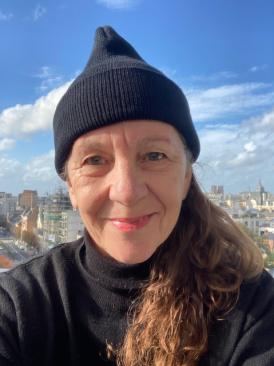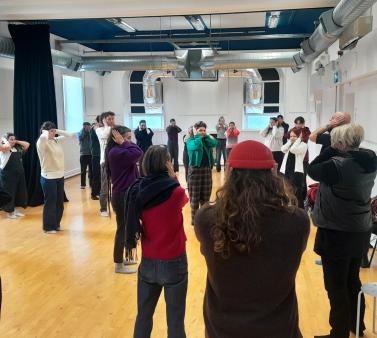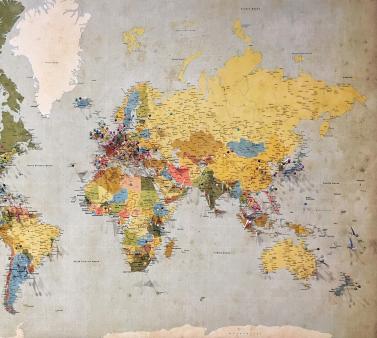
Professor Panet-Raymond is a woman on the move. She has toured her own dance works nationally and internationally and is an award-winning choreographer for music and performance productions. She has collaborated with a number of artists both for the stage and site-specific residencies, such as the Zone of Silence in the northern Mexican desert and the Québec boreal forest. She has received funding for research on dance and sociocultural transmission undertaken in Myanmar, Indonesia, Russia, Eastern Europe and Mexico. She is also the most recent guest professor at Rennes 2 University, where she is being hosted by the CAPS graduate school program. Having arrived in September, below she talks to us about her ongoing collaboration with the CAPS program and some of her other ongoing projects.
Could you tell me a bit about how your collaboration with the CAPS program began?
Silvy Panet-Raymond: In 2016, I met a Rennes 2 Teaching and Research Associate, Ophélie Naessens, who had received a travel bursary to develop cooperation between Rennes 2 and Concordia University. She was also accompanying Rennes based choreographer Alain Michard. We exchanged a lot about Concordia’s dance program and some of the different things happening in Rennes. I was subsequently invited as a guest artist by the UFR Arts Plastiques in the fall of 2018, and that gave me the opportunity to work with the visual arts students here and meet some of the faculty and other guest artists.
A while later, Marion Hohlfeldt (Director of CAPS) and some of her colleagues came to visit Concordia and I gave them a tour of our facilities, including something called the Milieux Institute for Art, Culture and Technology. It houses 8 research clusters that are very eclectic and dynamic centering on: performing arts, Indigenous futures, speculative life, media history, technoculture art and games, post image, textiles and materiality, and participatory media. I think the Rennes team was quite inspired by that structure - that particular form of bringing together researchers and artists and students and having both the artistic practice and the research practice mixing in that manner.
They had already started working on the development of the CAPS program and our collaboration really started to grow at that point. I provided some input on the pedagogical and collaborative aspects of the program. At the same time, they had already secured partnerships with many institutions, some of which are currently international partners of the program. Among these, the Bauhaus University in Weimar (Germany) was particularly active, with one of their doctoral students, Martin Leibinger who launched a project called the Public Arts Garage (PAG), as part of his thesis. The PAG is a form of interdisciplinary practice, research and pedagogy. I asked a colleague, Concordia’s Associate Dean of Research for the Faculty of Arts and Science, Patrick Leroux, if we might be able to do a seminar similar to what the PAG had done with Rennes 2, University College Cork (Ireland) and University of Barcelona a few months earlier. My colleague agreed and so we co-created and co-taught a graduate seminar based on the PAG model with CAPS partners from Weimar Bauhaus and Queen's University Belfast (UK). Hybrid teaching allowed us to create teams of graduate students from the three institutions, with some students located in China and South America. The team projects were very successful and showed that the PAG / CAPS outreach could produce creative and tangible outcomes. Concordia's 4th Space team put together videos of the initial and final versions of these presentations. Plus, it was great timing since it preceded the pedagogical launch of the CAPS Master’s program in September 2022.
So you helped to develop the diverse array of potential partnerships and projects from quite early on?
Yes, in a way I'm wearing two hats: that of the International Chair in Social Sciences and Humanities where I help to construct partnerships, but I'm also a guest artist. I've got a space at the Bois de Perrin site where I do my work and give artistic seminars for the Master’s program. In my workshops, we develop individual and collective projects through performative approaches. We explore different ways of embodying one's creative research and how it can extend to the public space. The interdisciplinary nature of CAPS and the fact that it's housed at Bois Perrin, off campus, means that students actively engage in shaping the place where they experiment, study, live and cook together.

For example, how do we diversify our experience of the public space so as to create a ground for things to grow? The possibilities are vast. There are people in CAPS who are from a variety of fields like geography, literature, media and technology, sociology and the visual arts. Over time, I've invented or adapted pedagogical approaches to address the diversity of perspectives students bring to the course and conversely, it also feeds my own projects.
I'm also working with the doctoral students, helping them how to rethink their research practices and protocols in relation to the body, to physically materialize and embody their ideas. It's pretty efficient way of revealing how ideas can take shape, can be transmitted.
For example, years ago at Concordia I was working on a program called CoLaBor. It involved Bordeaux University, Laval University and Concordia and it was a summer institute in university pedagogy. We were working with university professors from all sorts of disciplines from chemical engineering to nursing sciences, to design arts and languages. I was giving workshops on topics like mobility, how do we create mobility in a classroom setting? How do we engage students in a fixed environment but with mobile information? How do we teach these kinds of conundrums? And then how can we imagine different ways in which the human being engages in architecture? How do we use technological tools to go from the virtual to the embodied, and vice versa? These are the sort of topics that I also work on in the project I created called Ensemble Ouvert.
Could you tell me more about “Ensemble Ouvert”? What first motivated you to start this project?
It came together in a bit of a zeitgeist context. We know that what happens in a classroom is often a kind of a microcosm of what's happening in society. I noticed that there were ideological rifts that were forming between, on the one hand, how a person defines oneself by their craft and technical expertise, and then, on the other side, students who were more apt to a different kind of artistic, expressive freedom. I really felt that this sort of specializing by opposition mentality was not very conducive to learning. And besides, teaching in these conditions is not much fun. So, I quickly had to find ways of circumventing the resistance that had grown between them and within themselves. Hopefully, they would also get to expand their potential beyond their own views and opinions, maybe work across / with differences.
By removing some obstacles that were linked to things like expectations, justifications and explanations, we were left with the act of simply creating.
I came up with an approach that included three things: authority, authorization and authorship, as key areas in which we could rethink how we were going to function together. I was looking for something that would be very simple to work with but that in the background touched on very complex issues, similar to the notion of simplexity. So I came up with this process and I tried it in a class, and it was immediately clear to me that I’d hit on something very interesting. By removing some obstacles that were linked to things like expectations, justifications and explanations, we were left with the act of simply creating.
That provided us with a really dynamic opportunity for rethinking how we were going to work together. By creating that kind of acceptance of the openness, I saw that it boosted people's confidence; they were a lot more willing to playfully try things out. In removing the whole notion of hierarchy, you’re creating a new type of open space and system. In fact, there are times when I feel that students are teachers of teachers. I know that I would not have taught myself some of the things I’ve learned without having been in certain teaching contexts.
And that distinct notion of an open system is something that has been integrated into the structure of CAPS activities as well?
Yes, I try to bring these notions into everything I do, including my work with CAPS. As I mentioned earlier, another key recurring theme concerns mobility; that is to say, mobility of spirit, mobility of body, mobility of ideas, etc. How can we remain mobile, particularly as we're working with creative approaches to public space? Well, a public space at 10 am is not the same as the public space at 6 pm. Although it's creative approaches to public space, it should also almost be called creative approaches to space and time. Because if you think of creative approaches to public space in a static sort of way, you're forgetting that space has a life in time. It has a life in time because people are mobile. People are engaging in the space and people are crossing through it. They’re bringing part of their life into it and then taking part of their life out of it. So I try to get students to exercise that mobility, and it doesn't mean you have to be a great dancer to do it. You have to be able to sort of dance your ideas, make your ideas move. If you allow that freedom into your mind, then you can continue to change.
Professor Panet-Raymond’s current artistic activities include her ongoing transmission project Ensemble Ouvert with contributions from over 200 artists from all continents and disciplines. She is also working to help develop a summer school program with CAPS and a possible microcredit course next year.



